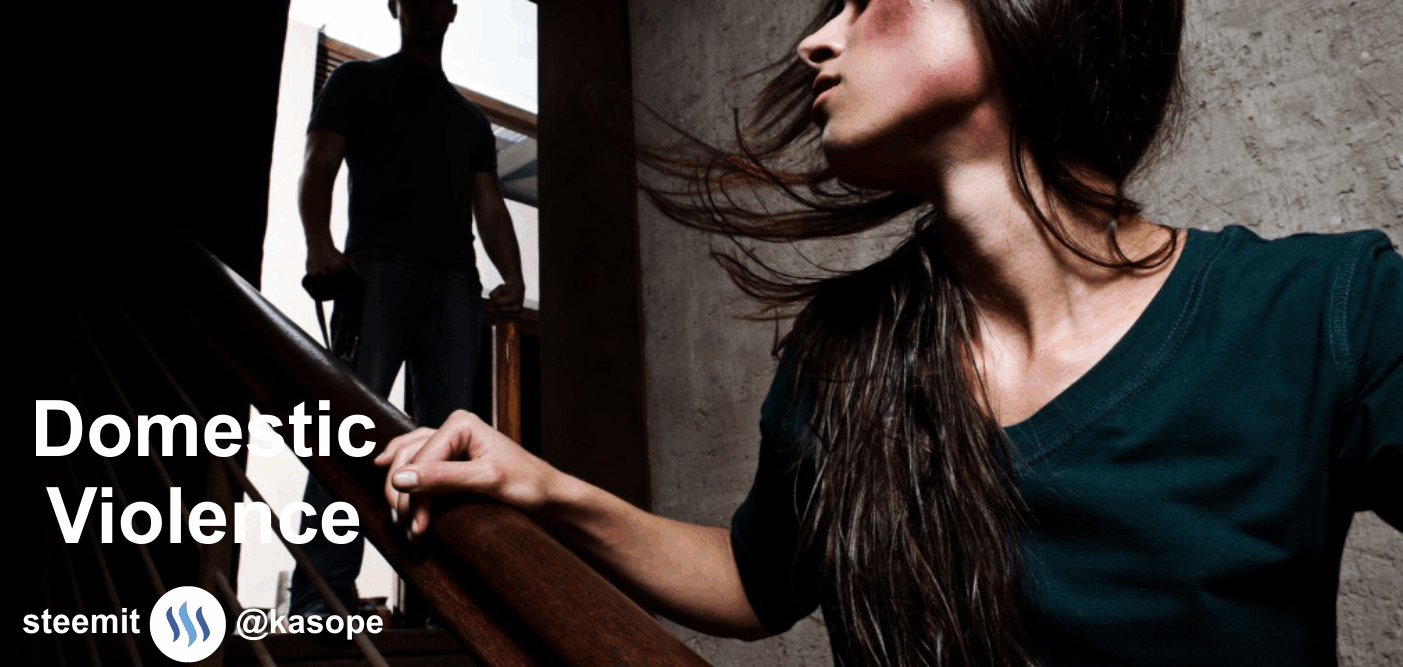DOMESTIC VIOLENCE: WHO TAKES THE BLAME?

@utopian-io @astoldbyv @veejay @sweetestglo-eu @youngarcher37 @theheralds @astoldbyv @safwenrekik @youngarcher37 @papaudeme @vickiebwoy @destinysaid @hcomusic @awofolaju @tommyinthesun @playitfoward @cabelindsay @grobens @andyjaypowell @icedrum @falseyedols @indesta120282 @kiloindigo @wartrapa @denis.savisko @kaykunoichi @sweetsssj @canadiancoconut @adsactly @steempower @ejemai @onos @kemjnr @engrbrain1 @tojukaka @sussan @ajibade
kindly read through, UPVOTE AND RE-STEEM . Thanks
According to the oxford English dictionary, domestic violence (also known as intimate
partner violence) is a pattern of behaviour which involves violence or other abuse by one person against another in a domestic setting, such as in marriage or cohabitation. It is a violence committed by a member of a family or household against another. Domestic violence are behaviors exhibited by one person in a relationship to control the other. Partners may be married or not married, heterosexual, gay, lesbian; living together, separated or dating. violence, a phenomenon with a very high occurrence rate, and can be found In most (if not all) families in the world regardless of the educational status, economic buoyancy, residence in developed communities of countries of the world.
Domestic violence are of types which includes physical, sexual, economic and emotional/psychological domestic violence. All the types can be found in "all societies" and well pronounced except for the emotional domestic violence which arguably causes most devastating effect.
The U.S. Department of Justice defines emotionally abusive traits as including causing fear by:
i. intimidation,
ii. threatening physical harm to self, partner, children, or partner's family or friends,
iii. destruction of pets and property,
iv. forcing isolation from family, friends, school or work.
Subtler emotionally abusive tactics include insults, putdowns, arbitrary and unpredictable
inconsistencies and gas lighting (the denial that previous abusive incidents occurred). Modern
technology has led to new forms of abuse: by text messaging and cyber-bullying (Tjaden &
Thoennes, 2000).
The insecurity in the family leaves room for much violence as studies in Lagos, Ekiti, Akwa
Ibom and Enugu States in Nigeria have shown that there is a high prevalence of psychological
abuse and neglect of the elderly in Nigeria with women bearing a considerably heavier yoke (Mudiare, 2013).
BUT WHO CAN BE BLAMED FOR THESE OCCURRENCES?
Although, It obviously can not be ignored that men and women in families have direct cause in the occurrence of domestic violence, what really propel them to be involved?
As social beings, the role the society plays in our makeup can not be overemphasized. The principles of socialization and of course the internalization or norms and values is held in high esteem.
Now let's see how cultures contribute to what we see in families today...
CULTURAL BELIEFS OF DOMESTIC VIOLENCE
Cultural and social norms are highly influential in shaping individual’s behaviour, including the use of violence. Norms can protect against violence, but they can also support and encourage the use of it. For instance, cultural acceptance of violence, either as a NORMAL method of resolving conflict or as a usual part of rearing a child is a risk factor for all types of interpersonal violence. Often unspoken, these norms offer social standards of appropriate and inappropriate behaviour, govern what is (and is not) acceptable and coordinate our interactions with others (Durlauf, & Blume, 2008).
Cultural and social norms persist within society because of individuals’ preference to conform, given the expectation that others will also conform. A variety of external and internal pressures are thought to maintain cultural and social norms (Durlauf, & Blume, 2008).
Thus, individuals are discouraged from violating norms by the threat of social disapproval or punishment and feelings of guilt and shame that result from the internalization of norms. Cultural and social norms do not necessarily correspond with an individual’s attitudes (positive or negative feelings towards an object or idea) and beliefs (perceptions that certain premises are true), although they may influence these attitudes and beliefs if norms becomes internalized. Cultural and social norms also vary widely. So, behaviour acceptable to one social group, gang or culture may not be tolerated in another. Different cultural and social norms support different types of violence. Therefore, culture determines what makes up domestic violence in different societies.
For instance, traditional beliefs that men have a right to control or discipline women through physical means make women vulnerable to violence by intimate partners (Ilika, 2005) and place girls at risk of sexual abuse (Jewkes, Penn-Kekana & Rose Junius ,2005).
Equally, cultural acceptance of violence, including sexual violence, as a private affair hinders outside intervention and prevents those affected from speaking out and gaining support. In many societies, victims of sexual violence also feel stigmatized, which inhibits reporting (Hussain & Khan, 2008).
Furthermore, alcohol related violence is considered more likely in cultures where many believe that alcohol plays a positive role in helping people to shed their inhibitions. Here, alcohol can be used as a justification for violent behaviour, or consumed to fuel the courage needed to commit violent crimes.
Child maltreatment is encouraged in some African and Asian societies where:
i. female children are valued less in the society than males and considered to have less social
and economic potential,
ii. children have a low status in the society and within the family.
iii. physical punishment is an acceptable or normal part of rearing a child,
iv. communities adhere to harmful traditional and cultural practices such as genital mutilation
(e.g. Nigeria).

Intimate partner violence can be found in cultures where:
i. a man is socially superior and has a right to assert his power over a woman
ii. a man has a right to “correct” or discipline a female,
iii. a woman’s freedom should be restricted,
iv. physical violence is an acceptable way to resolve conflicts within a relationship,
v. a woman is responsible for making a marriage work,
vi. intimate partner violence discussion is a taboo and reporting abuse is disrespectful,
vii. divorce is shameful,
viii. dowry (financial payment from the bride’s family to the husband) or bride wealth (financial
payment from the husband to the bride’s family) is an expected part of marriage, violence
can occur either because financial demands are not met, or because bride wealth becomes
synonymous with purchasing and thus owning a wife,
ix. a man’s honor is linked to a woman’s sexual behaviour. Here, any deviation from sexual
norms disgraces the entire family, which can then lead to honor killing.
Also, some societies believe that Sex is a man’s right in marriage, girls are responsible for
controlling a man’s sexual urge, sexual violence is an acceptable way of putting women in
their place or punishing them, sexual activity (including rape) is a marker of masculinity and
sex and sexuality are taboo subjects, thus, encouraging sexual violence (Larme, 1997).
AND NOW WHO DO YOU BLAME FOR DOMESTIC VIOLENCE ?
WATCHOUT FOR MY SERIES ON "GENDER DIFFERENCES AND DOMESTIC VIOLENCE"
-Kasope
REFERENCES
Durlauf, N. & Blume, E. (2008). New Palgrave Dictionary of Economics, Second Edition. London, Macmillan.
Hussain, R. & Khan A. (2008). Women's perceptions and experiences of sexual violence in marital relationships and its effect on reproductive health. Health Care for Women International. 29:468–483.
Ilika, L. (2005). Women’s perception of partner violence in a rural Igbo community. AfricanJournal of Reproductive Health. 9:77–88.
Jewkes, R., Penn-Kekana, L. & Rose-Junius H. (2005). ‘‘If they rape me, I can’t blame them”: reflections on gender in the social context of child rape in South Africa and Namibia. Journal of Social Science and Medicine. 61:1809–1820.
Larme, A. (1997). Health care allocation and selective neglect in rural Peru. Journal of Social Science and Medicine. 11:1711–1723.
Mudiare, P. (2013). Abuse of the Aged in Nigeria: Elders Also Cry. American International Journal of Contemporary Research. Zaria, Vol. 3 No. 9.
Tjaden, P. & Thoennes, N. (2000). ‘Extent, nature, and consequences of intimate partner violence: findings from the National Violence against Women Survey’. Washington (DC):Department of Justice (US). Publication No. NCJ 181867.
Hi @kasope, I'm @checky ! While checking the mentions made in this post I noticed that @playitfoward and @indesta120282 don't exist on Steem. Did you mean to write @playitforward and @lndesta120282 ?
If you found this comment useful, consider upvoting it to help keep this bot running. You can see a list of all available commands by replying with
!help.Congratulations @kasope! You received a personal award!
Click here to view your Board of Honor
Congratulations @kasope! You received a personal award!
You can view your badges on your Steem Board and compare to others on the Steem Ranking
Vote for @Steemitboard as a witness to get one more award and increased upvotes!